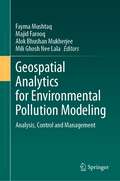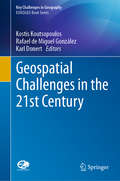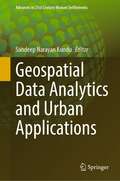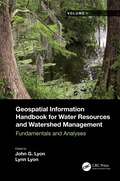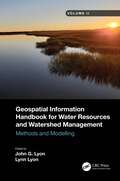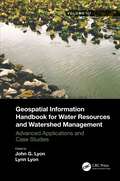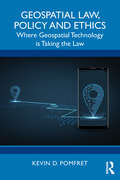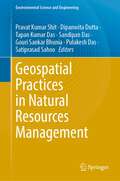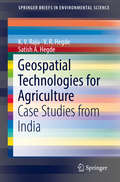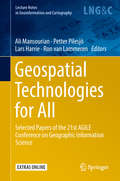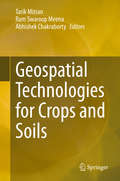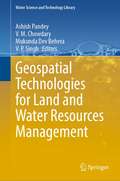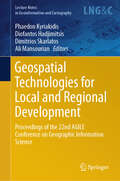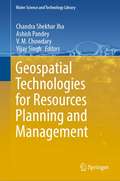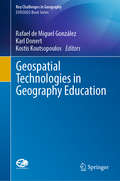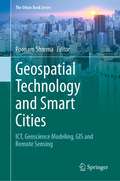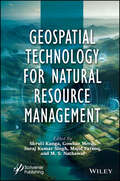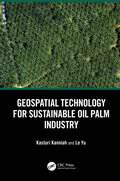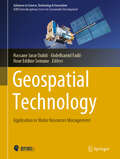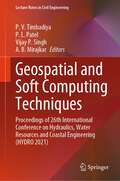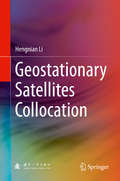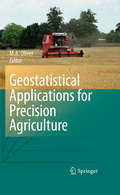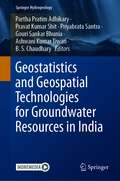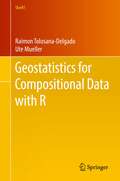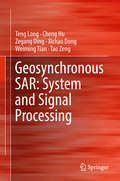- Table View
- List View
Geospatial Analytics for Environmental Pollution Modeling: Analysis, Control and Management
by Majid Farooq Fayma Mushtaq Alok Bhushan Mukherjee Mili Ghosh Nee LalaThis book aims to provide a comprehensive study on various aspects of environmental pollution dynamics using geospatial technology and modeling techniques. The utility of geospatial technology will be demonstrated for the effective study of environmental pollution, as space and location are very important for effective environmental health surveillance. The timeliness of the work is due to the increasing relevance of geospatial technology applications in environmental health investigations. Moreover, different types of pollution are covered in detail, including air and soil, all of which are analyzed using latest Remote Sensing and GIS technology. The basics of environmental pollution and its impacts are covered in the book's first part, while the second part focuses on the use of geospatial technology in investigating and modeling various instances of environmental pollution. The third part discusses policy measures for mitigating environmental pollution hazards, using geospatial analyses and data to craft informed policy decisions. The primary audience for the book is researchers working in the field of environmental pollution with incorporation of geospatial technology, including upper-level undergraduate and graduate students taking courses in remote sensing and its environmental applications. The secondary audience is academicians, planners, environmentalists and policymakers working in the field of environment protection and management.
Geospatial Challenges in the 21st Century (Key Challenges in Geography)
by Rafael de Miguel González Kostis Koutsopoulos Karl DonertThis book focuses on 21st century geospatial technologies (GT). It highlights their broad range of capabilities and their essential role in effectively addressing and resolving critical everyday issues, such as environment, sustainability, climate change, urban planning, economy, culture and geopolitics. Featuring chapters written by leading international scientists, it discusses the application of GT tools and demonstrates that the problems requiring such tools transcend national boundaries, cultures, political systems and scientific backgrounds on a global scale. In addition, it enhances readers’ spatial understanding of, and geographical reasoning in connection with, societal issues. The book will appeal to scientists, teachers and students of geography, the earth sciences and related areas, as well as decision-makers interested in the application and capabilities of geospatial technologies and new, spatial methods for addressing important issues.
Geospatial Data Analytics and Urban Applications (Advances in 21st Century Human Settlements)
by Sandeep Narayan KunduThis book highlights advanced applications of geospatial data analytics to address real-world issues in urban society. With a connected world, we are generating spatial at unprecedented rates which can be harnessed for insightful analytics which define the way we analyze past events and define the future directions. This book is an anthology of applications of spatial data and analytics performed on them for gaining insights which can be used for problem solving in an urban setting. Each chapter is contributed by spatially aware data scientists in the making who present spatial perspectives drawn on spatial big data. The book shall benefit mature researchers and student alike to discourse a variety of urban applications which display the use of machine learning algorithms on spatial big data for real-world problem solving.
Geospatial Information Handbook for Water Resources and Watershed Management, Volume I: Fundamentals and Analyses
by Lyon John G.Volume I of Geospatial Information Handbook for Water Resources and Watershed Management discusses fundamental characteristics, measurements, and analyses of water features and watersheds including lakes and reservoirs, rivers and streams, and coasts and estuaries. It presents contemporary knowledge on Geospatial Technology (GT)–supported functional analyses of water runoff, storage and balance, flooding and floodplains, water quality, soils and moisture, climate vulnerabilities, and ecosystem services. Captures advanced Geospatial Technologies (GTs) addressing a wide range of water issues Provides real-world applications and case studies using advanced spectral and spatial sensors combined with geospatially facilitated water process models Details applications of ArcInfo/ArcGIS, Google Earth Engine, and other systems using advanced remote sensors, including hyperspectral ER2 AVIRIS, Sentinel-1 and -2, MODIS, Landsat 7 ETM+, Landsat 8 OLI and TIPS, SAR radar, and thermal imaging Global in coverage with applications contributed by more than 170 authors with lifelong expertise in water sciences and engineering This handbook is a wide-ranging and contemporary reference of advanced geospatial techniques used in numerous practical applications at the local and regional scales and is an in-depth resource for professionals and the water research community worldwide.
Geospatial Information Handbook for Water Resources and Watershed Management, Volume II: Methods and Modelling
by G. Lyon JohnVolume II of Geospatial Information Handbook for Water Resources and Watershed Management discusses Geospatial Technology (GT) approaches using integrated modeling as applied to advanced water resource assessments. Features include multiple date land cover analyses as change in land cover influences water quality, model sensitivity analyses of DEM resolution and influences on modeling water characteristics like Manning’s n, development of seabed cover classification and sensitivity, and forecasting urban growth over time with climate vulnerability impacts on water. A detailed case study presents a range of water quality issues, all effectively demonstrating GT inputs to water quality studies from headwaters to receiving estuarine waters. Also analyzed are the comparison of evapotranspiration simulation performance by APEX model in dryland and irrigated cropping systems and perspectives on the future of transient storage modeling. Captures advanced technologies and applications for implementation with models to address a broad spectrum of water issues Provides real-world applications and case studies using advanced spectral and spatial sensors combined with geospatially facilitated water process models Features a Neuse River Basin case study integrating hydrologic methods and modeling along with remote sensing and GIS technologies for nonpoint source water quality evaluations Global coverage with applications demonstrated by more than 170 experts from around the world This handbook is a wide-ranging and contemporary reference of advanced geospatial techniques used in numerous practical applications at the local and regional scale and is an in-depth resource for professionals and the water research community worldwide.
Geospatial Information Handbook for Water Resources and Watershed Management, Volume III: Advanced Applications and Case Studies
by G. Lyon JohnVolume III of Geospatial Information Handbook for Water Resources and Watershed Management discusses water and watershed issues such as water quality, evapotranspiration, water resource management, and ecological services. Featured is a two-stage ditch and river geomorphology case study section with related water geospatial applications, including historical image analyses of floodplains and channels and resulting change in river geomorphology through erosion and transport and influence on dependent vegetation communities. Captures advanced Geospatial Technologies (GT) and their applications to address a wide spectrum of water issues Provides real-world two-stage ditch and river geomorphology case studies using river, stream and channel measures and change models, and bankfull discharge modeling Global in coverage with applications demonstrated by more than 170 experts in water sciences and two-stage ditch and river geomorphology This handbook is a wide-ranging and contemporary reference of advanced geospatial techniques used in numerous practical applications at the local and regional scale and is an in-depth resource for professionals and the water research community worldwide.
Geospatial Law, Policy and Ethics: Where Geospatial Technology is Taking the Law
by Kevin D. PomfretThis comprehensive textbook identifies the emerging legal, policy, and ethical considerations associated with the collection, analysis, storage, and distribution of data that can be tied to location on Earth – otherwise known as “geospatial information.”Drawing on the author’s extensive professional, legal, and scholarly experience in the geospatial community, the book explains how these issues cut across both legal and technology domains and how they impact geospatial information management across the globe. While focused on the USA, the framework and analysis can be applied to other nations and legal systems. Key topics covered include intellectual property, privacy, data protection, data quality and liability, security, ethical issues, licensing, and the impact of existing and emerging technologies, such as artificial intelligence, satellites, drones, software, machine learning, small satellites, and 5G. The book includes helpful features, such as a glossary of key legal terms and further reading, and is accompanied by digital supplements in the form of PowerPoint slides for each chapter.Geospatial Law, Policy and Ethics is the ideal companion for advanced undergraduate and graduate-level students of Geographic Information System (GIS), remote sensing geospatial intelligence, geospatial studies, and spatial data science courses. It will also be of interest to geospatial professionals employed in industry, government, or research.
Geospatial Practices in Natural Resources Management (Environmental Science and Engineering)
by Tapan Kumar Das Gouri Sankar Bhunia Pravat Kumar Shit Pulakesh Das Dipanwita Dutta Sandipan Das Satiprasad SahooThis book provides a multidisciplinary synthesis of the sustainable management of natural resources. The book presents applicable knowledge of land, water, and forest resources along with in-depth investigations of multiple management pathways. This book also demonstrated the contemporary applications of geospatial technology in data mining techniques, data analysis, modeling, assessment, and visualization, and appropriate management strategies in different aspects of natural resources. The book explores the latest state-of-the-art techniques using open-source software, statistical programming, and modeling platforms, including artificial intelligence techniques in natural resource management. It is a valuable resource for students, researchers, and practitioners in geography, geospatial sciences, and environmental sciences, especially those interested in land, water, and forest resources.
Geospatial Technologies for Agriculture: Case Studies from India (SpringerBriefs in Environmental Science)
by K. V. Raju V. R. Hegde Satish A. HegdeThis book uniquely presents accurate and up-to-date information related to crops in small and fragmented agricultural lands with mixed cropping patterns. The book involves research using remote sensing (RS), Global Positioning Systems (GPS) and Geographic Information Systems (GIS) to develop crop inventories in three growing seasons in three villages across India to inform decision makers and planners on best practices for agricultural management. The data analysis of crop details using various geospatial technologies fills in gaps in statistical agriculture research, and provides reliable, replicable and efficient methods for generating agricultural statistics. The book will be of interest to statisticians, planners and decision makers in crop management and production.
Geospatial Technologies for All: Selected Papers Of The 21st Agile Conference On Geographic Information Science (Lecture Notes in Geoinformation and Cartography)
by Ron Van Lammeren Ali Mansourian Petter Pilesjö Lars HarrieThis book presents the research papers accepted for the 21st AGILE Conference on Geographic Information Science, held at Lund University Geographical Information Systems (GIS) Centre, Sweden on 12–15 June 2018. It discusses the role of geospatial technologies in the digitalization of society and is intended primarily for professionals and researchers in fields that can benefit from geoinformation – both within and outside the area of geographic information science.
Geospatial Technologies for Crops and Soils
by Ram Swaroop Meena Tarik Mitran Abhishek ChakrabortyThe sustainable development of the agriculture sector is the only option to meet the demands of increased and economically viable production in a changing climate. This means there is a need to introduce the latest technologies to enhance production, and also help policymakers make decisions for the future. Geospatial technologies & tools, such as remote sensing, geographical information systems (GIS), global positioning systems (GPS), and mobile & web applications, provide unique capabilities to analyze multi-scale, multi-temporal datasets, and support decision-making in sustainable agriculture development and natural resources management. Further, the availability of reliable and timely geospatial information on natural resources and environmental conditions is essential for sustainable agricultural development and food security. Since remote sensing solutions are fast, non-destructive and have large spatial coverage, they can play a significant role in the identification, inventory, and mapping of land resources. Over the past four decades, remote sensing has proved to be a cost-effective and powerful tool to assess crop and soil properties in varying spatial and temporal scales using both visual and digital techniques. Satellite remote sensing coupled with GIS & mobile-app based positional information has emerged as an efficient tool for optimizing input resources, and minimizing cost of production and risk of biotic/ abiotic factors nature to promote sustainable agriculture. This book comprehensively documents the applications of space-based technologies for crop and soil assessments for the sustainable development of agriculture.
Geospatial Technologies for Land and Water Resources Management (Water Science and Technology Library #103)
by V. P. Singh Ashish Pandey V. M. Chowdary Mukunda Dev BeheraThis book focuses on the application of geospatial technologies to study the land use land cover (LULC) dynamics, agricultural water management, water resources assessment and modeling, and studies on natural disasters. LULC dynamics is one of the major research themes for studying global environmental change using remote sensing data. The section on LULC dynamics covers the multi-variate criteria for land use and land cover classification and change assessment in the mountainous regions. Further, LULC change detection of the Tons river basin and LULC dynamics at decadal frequency are studied to derive adaptation and mitigation strategies. Landscape-level forest disturbance modeling, together with conservation implications, is also included. The watershed management approach is necessary for comprehensive management of land and water resources of any region, where studies on multi-criteria analysis for rainwater harvesting planning and its impact on land use land cover transformations in rain-fed areas using geospatial technologies are presented in this book.The book will be useful for academics, water practitioners, scientists, water managers, environmentalists, and administrators, NGOs, researchers, and students who are actively involved in the application of geospatial technologies in LULC studies, agricultural water management and hydrological modelling and natural disasters for addressing the challenges being posed by climate change while addressing issues of food and water securities
Geospatial Technologies for Local and Regional Development: Proceedings of the 22nd AGILE Conference on Geographic Information Science (Lecture Notes in Geoinformation and Cartography)
by Ali Mansourian Phaedon Kyriakidis Diofantos Hadjimitsis Dimitrios SkarlatosThis book includes the full research papers accepted by the scientific programme committee for the 22nd AGILE Conference on Geographic Information Science, held in June 2019 at Cyprus University of Technology, Limassol, Cyprus. It is intended primarily for professionals and researchers in geographic information science, as well as those in related fields in which geoinformation application plays a significant role.
Geospatial Technologies for Resources Planning and Management (Water Science and Technology Library #115)
by Vijay Singh Ashish Pandey V. M. Chowdary Chandra Shekhar JhaThis book focuses on the application of geospatial technologies for resource planning and management for the key natural resources, e.g. water, agriculture and forest as well as the decision support system (DSS) for infrastructure development. We have seen in the past four decades that the growing complexities of sustainable management of natural resources management have been very challenging. The book has been written to leverage the current geospatial technologies that integrate the remotely sensed data available from various platforms, the precise locational data providing geospatial intelligence, and the advanced integration tools of Geographical Information Systems (GIS). Geospatial technologies have been used for water resources management employing geomorphological characteristics, analysis of river migration pattern, understanding the large-scale hydrological process, wet land classification and monitoring, analysis of glacial lake outburst flood (GLOF), assessment of environmental flow and soil erosion studies, water quality modelling and assessment and rejuvenation of paleochannels through groundwater recharge. Geospatial technologies have been applied for crop classification and mapping, soil moisture determination using RISAT-1 C-band and PALSAR-2 L-band sensors, inventory of horticulture plantations, management of citrus orchards, crop yield forecasting, rice yield estimation, estimation of evapotranspiration and its evaluation against lysimeter and satellite-based evapotranspiration product for India to address the various issues of the agricultural system management. Geospatial technologies have been used for generation of digital elevation model, urban dynamics assessment, mobile GIS application at grass root level planning, cadastral level developmental planning and e-governance applications, system dynamics for sustainable development, micro-level water resources planning, site suitability for sewage treatment plant, traffic density assessment, geographical indications of India, archaeological applications and disasters interventions to elaborate various issues of DSS for infrastructure development and management. Geospatial technologies have been employed for the generation and reconciliation of the notified forest land boundaries, and also the land cover changes analysis within notified forest areas, forest resource assessment, management and monitoring and wildlife conservation and management. This book aims to present high-quality technical case studies representing the recent developments in the “application of geospatial technologies for resource planning and management”. The editors hope that this book will serve as a valuable resource for scientists and researchers to plan and manage land and water resources sustainably.
Geospatial Technologies in Geography Education (Key Challenges in Geography)
by Rafael de Miguel González Kostis Koutsopoulos Karl DonertThis book addresses new pedagogies focusing on the use of geospatial technologies and geomedia in the classroom. Today, geospatial technologies are substantially influencing geography teaching and learning, particularly in secondary education. Web-GIS, virtual globes, storytelling, maps and apps for mobile devices are transforming the nature and design of geography curricula, instructional processes, didactics, resources and assessments. Undoubtedly, geography is among those school subjects that have benefited most from the implementation of new technologies in the classroom. Geospatial technologies can be used to develop inquiry-based learning or project-based learning pedagogies and help students to acquire spatial reasoning and spatial citizenship skills in the context of education for sustainable development.This book highlights a range of initiatives, projects and educational practices – from several European countries and settings – related to geospatial challenges in geography education. Given its scope, it will be equally appealing to scientists, students and teachers of geography and other fields using geospatial technologies and geomedia.
Geospatial Technology and Smart Cities: ICT, Geoscience Modeling, GIS and Remote Sensing (The Urban Book Series)
by Poonam SharmaThis book presents fundamental and applied research in developing geospatial modeling solutions to manage the challenges that urban areas are facing today. It aims to connect the academics, researchers, experts, town planners, investors and government officials to exchange ideas. The areas addressed include urban heat island analysis, urban flood vulnerability and risk mapping, green spaces, solar energy, infrastructure management, among others. The book suggests directions for smart city research and outlines practical propositions. As an emerging and critical area of research and development, much research is now being done with regard to cities. At the international level and in India alike, the “smart cities” concept is a vital topic for universities and research centers, and well as for civic bodies, town planners and policymakers. As such, the book offers a valuable resource for a broad readership.
Geospatial Technology for Natural Resource Management
by Shruti Kanga Suraj Kumar Singh Gowhar Meraj Majid Farooq M. S. NathawatThis book is essential for anyone interested in understanding and implementing sustainable resource development strategies, as it covers the crucial first stage of assessing resource availability and condition, along with the use of modern geospatial technologies such as remote sensing, GIS, and GPS for surveying, mapping, and monitoring various resources for global environmental protection and sustainable development. The first step in developing a sustainable resource strategy is assessing the availability and condition of resources. This involves evaluating baseline levels, identifying trends, and understanding their consequences. Mitigation policies are then developed based on this assessment. Modern geospatial technologies like Remote Sensing (RS), Geographic Information Systems (GIS), and Global Positioning Systems (GPS) offer powerful tools for surveying, mapping, and monitoring both renewable and nonrenewable resources. These technologies support global environmental protection, disaster management, and sustainable development by providing repetitive and global data. GPS provides accurate geographic coordinates, while GIS allows visualization, analysis, and decision-making through spatial data, enabling the study of complex environmental and natural resource challenges at various scales.
Geospatial Technology for Sustainable Oil Palm Industry
by Kasturi Kanniah Le YuOil palm cultivation is known to be one of the leading causes of deforestation and degradation of the environment. This book introduces and explains the application of geospatial technology to an established and important tropical agricultural industry for responsible and sustainable management.
Geospatial Technology: Application in Water Resources Management (Advances in Science, Technology & Innovation)
by Hassane Jarar Oulidi Abdelhamid Fadil Nour Eddine SemaneThis book aims to exchange and share the experiences and research results on the geospatial technology applied in water resources management. It will present the most recent innovations, trends, challenges encountered and the solutions adopted in the area of geospatial technology. It will be beneficial for academicians, scientists, meteorologists, and consultants working in the field of water resources management.
Geospatial and Soft Computing Techniques: Proceedings of 26th International Conference on Hydraulics, Water Resources and Coastal Engineering (HYDRO 2021) (Lecture Notes in Civil Engineering #339)
by Vijay P. Singh P. V. Timbadiya P. L. Patel A. B. MirajkarThis book comprises the proceedings of the 26th International Conference on Hydraulics, Water Resources and Coastal Engineering (HYDRO 2021) focusing on broad spectrum of emerging opportunities and challenges in the field of soft computing and geospatial techniques in water resources engineering. It covers a range of topics, including, but not limited to, satellite derived data for hydrologic applications, GIS and RS applications in water resources management, rainfall and streamflow prediction, hydro-informatics, data driven and artificial intelligent based hydrological modelling, optimization of water resources systems, etc.Presenting recent advances in the form of illustrations, tables, and text, it offers readers insights for their own research. In addition, the book addresses fundamental concepts and studies in the field of Soft Computing and Geospatial Techniques in Water Resources Engineering, making it a valuable resource for both beginners and researchers wanting to further their understanding of hydraulics, water resources and coastal engineering.
Geostationary Satellites Collocation
by Hengnian LiGeostationary Satellites Collocation aims to find solutions for deploying a safe and reliable collocation control. Focusing on the orbital perturbation analysis, the mathematical foundations for orbit and control of the geostationary satellite. The mathematical and physical principle of orbital maneuver and collocation strategies for multi geostationary satellites sharing with the same dead band is also stressed. Moreover, the book presents some applications using the above algorithms and mathematical models to help readers master the corrective method for planning station keeping maneuvers. Engineers and scientists in the fields of aerospace technology and space science can benefit from this book. Hengnian Li is the Deputy Director of State Key Laboratory of Astronautic Dynamics, China.
Geostatistical Applications for Precision Agriculture
by Margaret A. OliverThe aim of this book is to bring together a series of contributions from experts in the field to cover the major aspects of the application of geostatistics in precision agriculture. The focus will not be on theory, although there is a need for some theory to set the methods in their appropriate context. The subject areas identified and the authors selected have applied the methods in a precision agriculture framework. The papers will reflect the wide range of methods available and how they can be applied practically in the context of precision agriculture. This book is likely to have more impact as it becomes increasingly possible to obtain data cheaply and more farmers use onboard digital maps of soil and crops to manage their land. It might also stimulate more software development for geostatistics in PA.
Geostatistics and Geospatial Technologies for Groundwater Resources in India (Springer Hydrogeology)
by Gouri Sankar Bhunia Pravat Kumar Shit Ashwani Kumar Tiwari Partha Pratim Adhikary Priyabrata Santra B. S. ChaudharyThis book offers essential information on geospatial technologies for water resource management and highlights the latest GIS and geostatistics techniques as they relate to groundwater.Groundwater is inarguably India's single most important natural resource. It is the foundation of millions of Indian farmers' livelihood security and the primary source of drinking water for a vast majority of Indians in rural and urban areas. The prospects of continued high rates of growth in the Indian economy will, to a great extent, depend on how judiciously we can manage groundwater in the years to come.Over the past three decades, India has emerged as by far the single largest consumer of groundwater in the world. Though groundwater has made the country self-sufficient in terms of food, we face a crisis of dwindling water tables and declining water quality. Deep drilling by tube wells, which was once part of the solution to water shortages, is now in danger of becoming part of the problem. Consequently, we urgently need to focus our efforts on the sustainable and equitable management of groundwater. Addressing that need, this book presents novel advances in and applications of RS–GIS and geostatistical techniques to the research community in a precise and straightforward manner.
Geostatistics for Compositional Data with R (Use R!)
by Raimon Tolosana-Delgado Ute MuellerThis book provides a guided approach to the geostatistical modelling of compositional spatial data. These data are data in proportions, percentages or concentrations distributed in space which exhibit spatial correlation. The book can be divided into four blocks. The first block sets the framework and provides some background on compositional data analysis. Block two introduces compositional exploratory tools for both non-spatial and spatial aspects. Block three covers all necessary facets of multivariate spatial prediction for compositional data: variogram modelling, cokriging and validation. Finally, block four details strategies for simulation of compositional data, including transformations to multivariate normality, Gaussian cosimulation, multipoint simulation of compositional data, and common postprocessing techniques, valid for both Gaussian and multipoint methods. All methods are illustrated via applications to two types of data sets: one a large-scale geochemical survey, comprised of a full suite of geochemical variables, and the other from a mining context, where only the elements of greatest importance are considered. R codes are included for all aspects of the methodology, encapsulated in the R package "gmGeostats", available in CRAN.
Geosynchronous SAR: System and Signal Processing
by Teng Long Cheng Hu Zegang Ding Xichao Dong Weiming Tian Tao ZengThis book chiefly addresses the analysis and design of geosynchronous synthetic aperture radar (GEO SAR) systems, focusing on the algorithms, analysis, methods used to compensate for ionospheric influences, and validation experiments for Global Navigation Satellite Systems (GNSS). Further, it investigates special problems in the GEO SAR context, such as curved trajectories, the Earth’s rotation, the ‘non-stop-and-go’ model, high-order Doppler parameters, temporal-variant ionospheric errors etc. These studies can also be extended to SAR with very high resolution and long integration time. Given the breadth and depth of its coverage, scientists and engineers in SAR and advanced graduate students in related areas will greatly benefit from this book.
